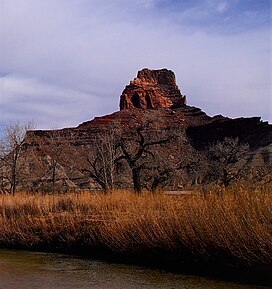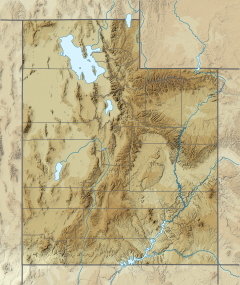| Assembly Hall Peak | |
|---|---|
 Northwest aspect | |
| Highest point | |
| Elevation | 6,395 ft (1,949 m) [1] [2] |
| Prominence | 1,055 ft (322 m) [1] |
| Parent peak | Window Blind Peak (7,030 ft) [1] |
| Isolation | 1.54 mi (2.48 km) [1] |
| Coordinates | 39°04′04″N 110°39′30″W / 39.0678469°N 110.6584424°W [3] |
| Geography | |
| Country | United States |
| State | Utah |
| County | Emery |
| Protected area | Mexican Mountain Wilderness |
| Parent range |
San Rafael Swell
[2] Colorado Plateau |
| Topo map | USGS Bottleneck Peak |
| Geology | |
| Age of rock | Late Triassic to Jurassic |
| Type of rock | Wingate Sandstone |
| Climbing | |
| Easiest route | class 5.10 climbing [1] |
Assembly Hall Peak is a 6,395-foot-elevation (1,949-meter) summit in Emery County, Utah, United States.
Description
Assembly Hall Peak is part of the San Rafael Swell and is located in the Mexican Mountain Wilderness Study Area which is administered by the Bureau of Land Management. [2] Towering nearly 1,300 feet above the surrounding terrain, it is situated 1.66 miles (2.67 km) east-northeast of Bottleneck Peak and 1.52 miles (2.45 km) north of Window Blind Peak, which is the nearest higher neighbor. [2] Precipitation runoff from the peak drains into the nearby San Rafael River. Topographic relief is significant as the summit rises nearly 1,300 feet (396 meters) above the river in 0.75 mile (1.2 km). Access to the mountain is via the Buckhorn Draw Road at Buckhorn Draw Campground. This mountain's toponym has been officially adopted by the U.S. Board on Geographic Names. [3]
Geology
This erosional remnant along the San Rafael River is composed of Wingate Sandstone, [4] which is the remains of wind-borne sand dunes deposited approximately 200 million years ago in the Late Triassic. [5] The Wingate overlays lightly colored Chinle Formation around the lower slopes of the peak and the surrounding area is composed of Moenkopi Formation.
Climate
According to the Köppen climate classification system, it is located in a Cold semi-arid climate zone, which is defined by the coldest month having an average mean temperature below 32 °F (0 °C), and at least 50% of the total annual precipitation being received during the spring and summer. [6] This desert climate receives less than 10 inches (250 millimeters) of annual rainfall, and snowfall is generally light during the winter. Spring and fall are the most favorable seasons to visit Assembly Hall Peak.
Climbing
Established climbing routes:
- Postcard of the Hanging – class 5.10 [7]
- Heavy Metal – class 5.10 [8]
- Leaning Pillar – class 5.10 [8]
- Lactic Stackidosis – class 5.10+ [8]
See also
Gallery
References
- ^ a b c d e "Assembly Hall Peak - 6,395' UT". listsofjohn.com. Retrieved 2023-08-23.
- ^ a b c d "Assembly Hall Peak, Utah". Peakbagger.com. Retrieved 2023-08-23.
- ^ a b "Assembly Hall Peak". Geographic Names Information System. United States Geological Survey, United States Department of the Interior. Retrieved 2023-08-23.
- ^ Stephen E. Strom, The Greater San Rafael Swell, University of Arizona Press (2022), ISBN 9780816543922, p. 62–63.
- ^ Mexican Mountain WSA, Utah BLM Statewide Wilderness Draft Environmental Impact Statement, Volume VI, East-Central Region, page 15.
- ^ Peel, M. C.; Finlayson, B. L.; McMahon, T. A. (2007). "Updated world map of the Köppen−Geiger climate classification". Hydrol. Earth Syst. Sci. 11. ISSN 1027-5606.
- ^ Cameron Burns, Selected Climbs in the Desert Southwest: Colorado and Utah, The Mountaineers Books (1999), ISBN 9780898866575, p. 167.
- ^ a b c 1995 American Alpine Journal, Mountaineers Books, p. 162.
External links
- Weather forecast: Assembly Hall Peak
- Assembly Hall Peak rock climbing: Mountainproject.com
- Assembly Hall Peak (photo): Flickr
- Assembly Hall Peak and Window Blind Peak: Flickr (photo)






